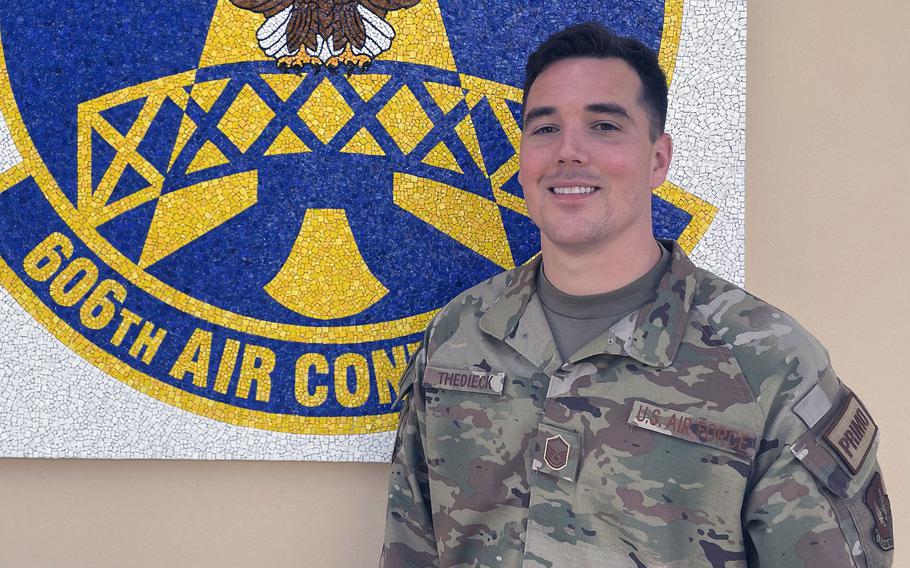
Master Sergeant Darren Thedieck poses for a photo in front of his unit crest at Aviano Air Base, Italy, on June 3, 2024. Thedieck has amassed a net worth of over $600,000, and he runs a Facebook group to offer investing insights to fellow service members. (Brian Erickson/Stars and Stripes)
AVIANO, Italy — Watching his mother struggle to find work made Air Force Master Sgt. Darren Thedieck money-conscious from a young age.
Even as a kid doing odd jobs, he nurtured the habit of setting aside a portion of his earnings. When he joined the service at 18, he was already intent on building his dream life by following the investment advice he’d gleaned through his voracious reading on personal finance.
Now the 31-year-old radio frequency transmission systems noncommissioned officer at Aviano Air Base has financial assets totaling $515,000, as well as collectibles and antiques that an online valuation he did estimated at $100,000.
While his nest egg grows toward his target of $1 million, he dispenses social media lessons with the aim of helping fellow service members duplicate his financial success on a military income.
“When I was 16, my dad had Bloomberg on (television), and neither my dad or my mom were really, truly financially literate, and we didn’t really talk about finances that much,” Thedieck said. “But I kind of gained interest from watching Bloomberg because I’d asked my dad, I was like, ‘What are those symbols?’ ”
After receiving an explanation that they were publicly traded companies, the Tallahassee, Fla., native went to a local bookstore and purchased a couple of books on investing.

U.S. Air Force Master Sgt. Darren Thedieck and his wife, Naudia, pose for a photo during their wedding in Denmark on April 29, 2023. Now 31, Thedieck started investing when he joined the Air Force at 18. His goal is to retire at 38 and be financially independent. (Darren Thedieck)
He spent the two years before graduating high school becoming as knowledgeable on the subject as he could and — at the urging of his father and grandfather, both of whom served in the Army — enlisted in the Air Force in 2011.
That same year, he started his investment journey by opening a Roth IRA to ensure tax-free income in retirement. Later, after further research, he created a taxable brokerage account to help grow his portfolio.
The brokerage account “offers me a little bit more flexibility” and potential liquidity, said Thedieck, who is married and has an infant daughter.
As a master sergeant with 13 years of service time, he earns base pay of just over $5,150 a month, which equates to a roughly $61,800 annual salary. With assorted allowances added in, his gross income is about $9,600 a month, or just over $115,000 a year.
Between maxing out his contribution to his IRA, the 20% of his base pay put into his Thrift Savings Plan and his contributions to his taxable brokerage account, he stashes away over $2,300 a month.
His current budget lists his monthly housing and utilities expenses at just under $2,300. Grocery expenditures range between $700 and $750 per month. He also has specific budget lines for dining out, car repair, insurance, subscriptions and other discretionary items such as travel.
“If you accomplish a budget, it can help you provide a snapshot of where your expenses are going,” Thedieck said. “And you might be surprised by doing a budget and seeing maybe I don’t necessarily need those four or five subscriptions.”
In 2017, when he set his sights on retiring early, he also began feeling a desire to start passing on his knowledge.
“I started off sponsored by the USO, (and then) developed my own finance class to teach both Army and Air Force service members in Korea,” he said.
Now seven years shy of his goal of retiring at 38 with financial independence, he is giving back through his public Facebook group, Financial Dream to Reality.
The group was created in 2020 and has over 800 members. Thedieck currently seeks to push out content on the page three times a week.
His foremost advice is “pay yourself first.” He recommends that people set aside a certain percentage for themselves.
Establishing an automatic allotment is a good idea, he said, adding that the amount could be as modest as $20 to $50 a week, which will “get you closer to your goals.” Thedieck started small and increased the allotment when he could.
“Think of yourself and what kind of person you want to be in 20 to 30 years,” he said. “And challenge yourself and say, ‘What do I need to do today to make sure I arrive at that point?’ ”